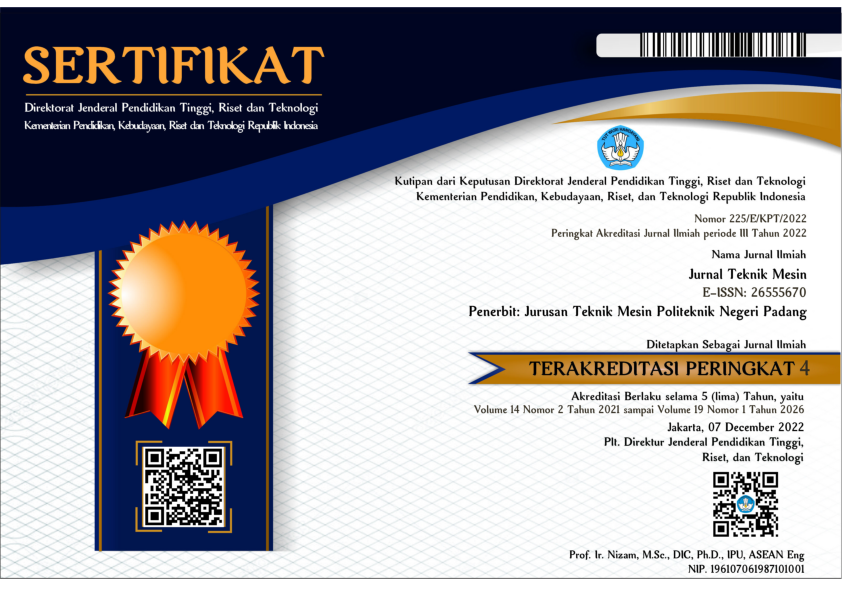Optimalisasi Temperatur Sintering Pada Sintered Body Hidroksiapatit Dengan Penambahan Silika Sebagai Material Penguat
Abstract
Sintered body hydroxyapatite (HA) in the form of pellets has been made by adding silica as a reinforcing material (ratio 60:40 wt.%) by varying the sintering temperature. HA and silica were subjected to a dry mixing process for 2 h, then a wet mixing process was carried out for 2 h with the addition of PVA and alcohol as a binder. The mixing process uses a rotary drum with the addition of zirconia balls with the aim of making the mixture more homogeneous. After the mixing process, the samples were dried for 48 h to remove the alcohol contained. The green body was made using the uniaxial pressing method at a pressure of 100 MPa and held for 3 minutes. The sintering process is carried out variously at temperatures of 800°C, 900°C, 1000°C, 1100°C, 1200°C, 1300°C, and 1400°C. with a heating rate of 5ºC/minute and holding time of 4 h. Next, the temperature was lowered to 300ºC with a cooling rate of 5ºC/minute. The results showed that linear shrinkage increased significantly (weight shrinkage increased 12.83% - 25.08% and diameter shrinkage increased 3.26% - 23.21%). The results of the relative density calculation show that there is a significant increase with each variation in sintering temperature, where the increase occurs from 44.4% - 85.6%. The compressive strength value also shows an increase with increasing sintering temperature, namely from 21.2 MPa at 800 oC to 65.9 MPa at 1300 oC. Meanwhile, at a sintering temperature of 1400°C, compressive strength values decreased and oxidation occurred as evidenced by color changes. It can be concluded that the optimization of the sintering process occurs at a temperature of 1300 oC which is proven by the highest compressive strength value and no oxidation occurs.
References
S.M.B. Respati, 2010, Bahan Biomaterial Stainless Steel Dan Keramik, Momentum. Vol. 6, pp. 5–8. https://publikasiilmiah.unwahas.ac.id/index.php/MOMENTUM/article/view/132/125.
D. Djuhana, M. Mulyadi, S. Sunardi, 2019, Efek Aditif SiO2 Terhadap Suhu Sintering Keramik Alumina dan Karakteristiknya, PISTON: Journal of Technical Engineering. Vol. 2 pp. 22–26. https://doi.org/10.32493/pjte.v2i1.3224.
A. Indra, R. Firdaus, I.H. Mulyadi, J. Affi, Gunawarman, 2020, Enhancing the physical and mechanical properties of pellet-shaped hydroxyapatite by controlling micron- and nano-sized powder ratios, Ceramics International. Vol. 46 pp. 15882–15888. https://doi.org/10.1016/j.ceramint.2020.03.136.
N.S. Wardani, A. Fadli, Irdoni, 2013, Sintesis Hidroksiapatit dari Cangkang Telur dengan Metode Presipitasi, Journal of the American Chemical Society. 123 (2013) 2176–2181.
A. Indra, 2021, Physical and Mechanical Properties of Hydroxyapatite Ceramics With a Mixture of Micron and Nano-Sized Powders: Optimising the Sintering Temperatures, Ceramics - Silikaty. Vol. 65 pp. 1–9. https://doi.org/10.13168/cs.2021.0022.
J.N. Setiadiputri, 2018, Sintesis dan Karakterisasi Biokomposit Hidroksiapatit-Alginat-Zinc Sebagai Bone graft Untuk Penanganan Bone Defect, Journal of Chemical Information and Modeling. Vol. 53 pp. 1689–1699.
S. Sulastri, S. Kristianingrum, 2010, Berbagai Macam Senyawa Silika : Sintesis, Karakterisasi dan Pemanfaatan, Prosiding Seminar Nasional Penelitian, Pendidikan Dan Penerapan MIPA. pp. 211–216.
S. Silahooy, Analisis Serbuk Silika Amorf (SiO2) Berbahan Dasar Pasir, Science Map Journal. 2 (2020) 75–78.
R. Hidayat, A. Subardi, A. Indra, 2022, Peningkatan Kekuatan Sintered Body Hidroksiapatit (HA) dengan Penambahan Silika Sebagai Material Penguat, ReTII. 2022 pp. 360–366.
N. Vargas-Becerril, D.A. Sánchez-Téllez, L. Zarazúa-Villalobos, D.M. González-García, M.A. Álvarez-Pérez, C. de León-Escobedo, L. Téllez-Jurado, 2020, Structure of biomimetic apatite grown on hydroxyapatite (HA), Ceramics International. Vol. 46 pp. 28806–28813. https://doi.org/10.1016/j.ceramint.2020.08.044.
A. Indra, A.B. Putra, N. Handra, H. Fahmi, Nurzal, Asfarizal, M. Perdana, Anrinal, A. Subardi, J. Affi, Gunawarman, 2022, Behavior of sintered body properties of hydroxyapatite ceramics: effect of uniaxial pressure on green body fabrication, Materials Today Sustainability. 17. https://doi.org/10.1016/j.mtsust.2021.100100.
A. Huang, H. Dai, X. Wu, Z. Zhao, Y. Wu, 2019, Synthesis and characterization of mesoporous hydroxyapatite powder by microemulsion technique, Journal of Materials Research and Technology. Vol. 8 pp. 3158–3166. https://doi.org/10.1016/j.jmrt.2019.02.025.
A. Indra, F. Hadi, I.H. Mulyadi, J. Affi, Gunawarman, 2021, A novel fabrication procedure for producing high strength hydroxyapatite ceramic scaffolds with high porosity, Ceramics International. Vol. 47 pp. 26991–27001. https://doi.org/10.1016/j.ceramint.2021.06.112.
A.S. Hammood, S.S. Hassan, M.T. Alkhafagy, H.L. Jaber, 2019, Effect of calcination temperature on characterization of natural hydroxyapatite prepared from carp fish bones, SN Applied Sciences. Vol. 1. https://doi.org/10.1007/s42452-019-0396-5.
S.M. Londoño-Restrepo, B.M. Millán-Malo, A. del Real-López, M.E. Rodriguez-García, 2019, In situ study of hydroxyapatite from cattle during a controlled calcination process using HT-XRD, Materials Science and Engineering C. 105, 110020. https://doi.org/10.1016/j.msec.2019.110020.
K.C. Vinoth Kumar, T. Jani Subha, K.G. Ahila, B. Ravindran, S.W. Chang, A.H. Mahmoud, O.B. Mohammed, M.A. Rathi, 2021, Spectral characterization of hydroxyapatite extracted from Black Sumatra and Fighting cock bone samples: A comparative analysis, Saudi Journal of Biological Sciences. Vol. 28 pp. 840–846. https://doi.org/10.1016/j.sjbs.2020.11.020.
F. Tikhani, M. Jouyandeh, S.H. Jafari, S. Chabokrow, M. Ghahari, K. Gharanjig, F. Klein, N. Hampp, M.R. Ganjali, K. Formela, M.R. Saeb, 2019, Cure Index demonstrates curing of epoxy composites containing silica nanoparticles of variable morphology and porosity, Progress in Organic Coatings. Vol. 135 pp. 176–184. https://doi.org/10.1016/j.porgcoat.2019.05.017.
Y. Zhang, Q. Yue, M.M. Zagho, J. Zhang, A.A. Elzatahry, Y. Jiang, Y. Deng, 2019, Core-Shell Magnetic Mesoporous Silica Microspheres with Large Mesopores for Enzyme Immobilization in Biocatalysis, ACS Applied Materials and Interfaces. Vol. 11 pp. 10356–10363. https://doi.org/10.1021/acsami.8b18721.
H. Xing, B. Zou, X. Liu, X. Wang, Q. Chen, X. Fu, Y. Li, 2020, Effect of particle size distribution on the preparation of ZTA ceramic paste applying for stereolithography 3D printing, Powder Technology. Vol. 359 pp. 314–322. https://doi.org/10.1016/j.powtec.2019.09.066.
D. Sofia, D. Barletta, M. Poletto, 2018, Laser sintering process of ceramic powders: The effect of particle size on the mechanical properties of sintered layers, Additive Manufacturing. Vol. 23 pp. 215–224. https://doi.org/10.1016/j.addma.2018.08.012.
H. Wu, Y. Cheng, W. Liu, R. He, M. Zhou, S. Wu, X. Song, Y. Chen, 2016, Effect of the particle size and the debinding process on the density of alumina ceramics fabricated by 3D printing based on stereolithography, Ceramics International. Vo;. 42 pp. 17290–17294. https://doi.org/10.1016/j.ceramint.2016.08.024.
C. Sun, X. Tian, L. Wang, Y. Liu, C.M. Wirth, J. Günster, D. Li, Z. Jin, 2017, Effect of particle size gradation on the performance of glass-ceramic 3D printing process, Ceramics International. Vol. 43 pp. 578–584. https://doi.org/10.1016/j.ceramint.2016.09.197.
F. Niu, D. Wu, F. Lu, G. Liu, G. Ma, Z. Jia, 2018, Microstructure and macro properties of Al2O3 ceramics prepared by laser engineered net shaping, Ceramics International. Vol. 44 pp. 14303–14310. https://doi.org/10.1016/j.ceramint.2018.05.036.
J. Ding, Q. Liu, B. Zhang, F. Ye, Y. Gao, 2020, Preparation and characterization of hollow glass microsphere ceramics and silica aerogel/hollow glass microsphere ceramics having low density and low thermal conductivity, Journal of Alloys and Compounds. 831 pp. 154737. https://doi.org/10.1016/j.jallcom.2020.154737.
M. Weiß, P. Sälzler, N. Willenbacher, E. Koos, 2020, 3D-Printed lightweight ceramics using capillary suspensions with incorporated nanoparticles, Journal of the European Ceramic Society. Vol. 40 pp. 3140–3147. https://doi.org/10.1016/j.jeurceramsoc.2020.02.055.













